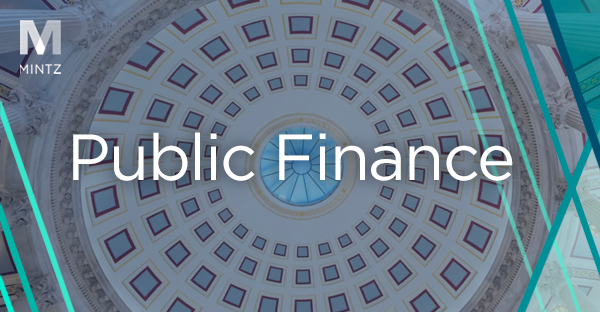
Public Finance
Viewpoints
Filter by:
IRA Update: IRS Releases Limited Guidance on Low-Income Community Adder and Establishes Allocation Program Needed to Make the Adder Available
February 16, 2023 | Alert | By Gregg M. Benson
IRA Update: IRS Announces Updated Reference Standard for Energy Efficient Commercial Building Property Deduction Under Section 179D
December 28, 2022 | Alert | By Gregg M. Benson
IRA Update: IRS Releases Reporting Requirements for EV Manufacturers and Sellers
December 22, 2022 | Alert | By Gregg M. Benson
Public Comments Requested on Additional Aspects of the IRA Clean Energy Tax Incentives, including Clean Hydrogen Production, Carbon Capture and Sequestration, Clean Commercial Vehicles and EV Charging Stations
November 7, 2022 | Alert | By Gregg M. Benson, Xandy Walsh, David Salamon
Last Call: Public Comments on Inflation Reduction Act Clean Energy Tax Incentives Are Requested By November 4
November 3, 2022 | Alert | By Gregg M. Benson, Xandy Walsh
On October, 5, 2022, the U.S. Department of Treasury and Internal Revenue Service published six Notices requesting public comments by November 4, 2022 on certain of the clean energy tax incentives included in the Inflation Reduction Act of 2022. However, the IRS and Treasury will consider written comments received after November 4 that do not delay the relevant guidance. Input from industry stakeholders is important to help inform next steps for the IRS and Treasury and shape how these clean energy tax incentives are accessed in practice.
Read more
Treasury and IRS Release Final Tax Regulations for LIBOR Replacement Amendments
January 7, 2022 | Advisory | By Christie Martin, Matthew O. Page
The alert provides background on the transition to a post-LIBOR world and reviews the tax guidance provided by the Department of Treasury and IRS in final regulations taking effect on March 7, 2022.
Read more
SEC’s Proposed Broker-Dealer Exemption May Apply to “Finders” for Municipal Securities
October 13, 2020 | Blog | By Steve Ganis
Final Section 529A ABLE Plan Regulations Are Well-Intended But Will Require Further Clarification
October 12, 2020 | Blog
On October 2, 2020, the Internal Revenue Service released final regulations providing guidance for Section 529A “qualified ABLE programs” established by states under the Stephen Beck Jr. Achieving a Better Life Experience Act of 2014 (the “ABLE Act”) to provide tax-favored savings and investment accounts for individuals with disabilities. Building on proposed regulations issued in 2015 and 2019 and several prior IRS notices as to how the final regulations would resolve specific issues under the ABLE Act, the final regulations clearly seek to avoid, within statutory constraints, imposing major administrative burdens on ABLE programs. Nonetheless, several key provisions contain ambiguities or raise concerns. As indicated by prior IRS guidance, the regulations provide a transition period of at least two years for ABLE programs operating in good faith to implement provisions applicable to such programs, and thus an opportunity for the IRS address such ambiguities and concerns through notices or other guidance prior to their full implementation.
Read more
The Coronavirus Aid, Relief, and Economic Security Act: Assistance Available to Passenger Airlines and Airports
March 31, 2020 | Blog | By Tim McKeon, William Kannel
On March 27, 2020, President Trump signed into law the “Coronavirus Aid, Relief, and Economic Security Act” (the “CARES Act”), a $2+ trillion stimulus package intended to ease the economic and social disruptions facing the country in the wake of the COVID-19 outbreak.
Read more
Congress Acts to Mitigate COVID-19 Impact
March 18, 2020 | Blog | By Anthony DeMaio, William Kannel
Below is an update on legislative efforts by Congress and the White House to address the coronavirus pandemic, prepared by our D.C. colleagues at ML Strategies, who are closely following these fluid and fast-moving developments. Efforts to provide a supply of low cost working capital to the many businesses and entities experiencing operational and/or cash flow disruption may be of particular interest to our bondholder clients.
Read more
SOFR So Good! IRS Makes It Easier to Say ‘Goodbye’ to LIBOR
October 10, 2019 | Alert | By Christie Martin, Matthew O. Page
This alert describes how Proposed Regulations from the IRS will help facilitate an orderly transition from LIBOR, with minimum cost and disruption to the market.
Read more
Risks of Imperfect Perfection, and How to Avoid Them
September 25, 2019 | Blog
Mintz’s Len Weiser-Varon recently published commentary in The Bond Buyer titled, “Uniform Commercial Code financing statement is integral in bond defaults.”
Read more
First Circuit Rules That “Incorporation by Reference” of Collateral Description in UCC Financing Statements May Not Perfect Lien
February 14, 2019 | Blog | By William Kannel, Eric Blythe
Tolstoy warned that “if you look for perfection, you’ll never be content”; but Tolstoy wasn’t a bankruptcy lawyer. In the world of secured lending, perfection is paramount. A secured lender that has not properly perfected its lien can lose its collateral and end up with unsecured status if its borrower files bankruptcy.
Read more
IRS Releases Proposed Regulations Consolidating Guidance on Reissuance of Tax-Exempt Bonds
January 11, 2019 | Blog | By Christie Martin
On December 31, 2018, the Department of Treasury and Internal Revenue Service released long-awaited proposed regulations (the “Proposed Regulations”) that address when modifications to the terms of tax-exempt bonds are treated as an exchange of existing bonds for newly issued (or “reissued”) bonds for purposes of section 103 and sections 141 through 150 of the Internal Revenue Code and when an issuer’s acquisition of its bonds results in such bonds ceasing to be outstanding for federal tax purposes.
Read more
Final Private Activity Bond Public Approval Regulations Streamline Notice Requirements
January 4, 2019 | Blog | By Christie Martin
On December 31, 2018, the Department of the Treasury and the Internal Revenue Service released final regulations (the “Final Regulations”) relating to public approval requirements for tax exempt private activity bonds. The Final Regulations update and streamline implementation of the public approval requirement for tax exempt private activity bonds provided in section 147(f) of the Internal Revenue Code and are largely an improvement over the existing regulations that date back to 1983.
Read more
IRS Expands Remedial Action for Nonqualified Use of Tax-Advantaged Bonds
April 13, 2018 | Alert | By Christie Martin
The IRS on April 11, 2018 released Revenue Procedure 2018-26 (Rev. Proc. 2018-26), which include the expansion of remedial action options in connection with certain post-issuance leases to private parties of facilities financed with tax-exempt bonds.
Read more
IRS Expands Remedial Action for Nonqualified Use of Tax-Advantaged Bonds
April 13, 2018 | Blog | By Christie Martin
The IRS on April 11, 2018 released Revenue Procedure 2018-26 (Rev. Proc. 2018-26), which expands remedial action options in connection with certain post-issuance leases to private parties of facilities financed with tax-exempt bonds.
Read more
Insolvent “On Behalf Of” Municipal Bond Issuers: Chapter 9, Chapter 11, or Ineligible?
February 26, 2018 | Blog | By William Kannel
Last week, President Trump unveiled his proposal to fix our nation’s aging infrastructure. While the proposal lauded $1.5 trillion in new spending, it only included $200 billion in federal funding.
Read more
Tax Reform: The Threat of Annihilation of Tax-Exempt Financing
November 9, 2017 | Blog | By Charles Samuels, Meghan Burke, John Regier
Mintz Levin's Chuck Samuels, Meghan Burke, Len Weiser-Varon, and John Regier discussed the new tax reform bill in a webinar entitled "Tax Reform: The Threat of Annihilation of Tax Exempt Financing.”
Read more
The Budget Reconciliation Process and the “Byrd Rule”: Implications for the Ongoing Tax Reform Effort
November 6, 2017 | Blog | By John Regier
In order to understand the context in which the current tax reform bill, H.R. 1, is being considered, it is important to know the meaning of two bits of Washington jargon: “budget reconciliation” and the “Byrd rule.”
Read more
Explore Other Viewpoints:
- Antitrust
- Appellate
- Arbitration, Mediation & Alternate Dispute Resolution
- Artificial Intelligence
- Awards
- Bankruptcy & Restructuring
- California Land Use
- Class Action
- Complex Commercial Litigation
- Construction
- Consumer Product Safety
- Cross-Border Asset Recovery
- Debt Financing
- Direct Investing (M&A)
- Diversity
- EB-5 Financing
- Education & Nonprofits
- Employment
- Energy & Sustainability
- Environmental Enforcement Defense
- Environmental Law
- FDA Regulatory
- Federal Circuit Appeals
- Financial Institution Litigation
- Government Law
- Growth Equity
- Health Care
- Health Care Compliance, Fraud and Abuse, & Regulatory Counseling
- Health Care Enforcement & Investigations
- Health Care Transactions
- Health Information Privacy & Security
- IP Due Diligence
- IPRs & Other Post Grant Proceedings
- Immigration
- Insolvency & Creditor Rights Litigation
- Institutional Investor Class Action Recovery
- Insurance & Financial Services
- Insurance Consulting & Risk Management
- Insurance and Reinsurance Problem-Solving & Dispute Resolution
- Intellectual Property
- Investment Funds
- Israel
- Licensing & Technology Transactions
- Life Sciences
- Litigation & Investigations
- M&A Litigation
- ML Strategies
- Medicare, Medicaid and Commercial Coverage & Reimbursement
- Mergers & Acquisitions
- Patent Litigation
- Patent Prosecution & Strategic Counseling
- Pharmacy Benefits and PBM Contracting
- Portfolio Companies
- Privacy & Cybersecurity
- Private Client
- Private Equity
- Pro Bono
- Products Liability & Complex Tort
- Projects & Infrastructure
- Public Finance
- Real Estate Litigation
- Real Estate Transactions
- Real Estate, Construction & Infrastructure
- Retail & Consumer Products
- Securities & Capital Markets
- Securities Litigation
- Special Purpose Acquisition Company (SPACs)
- Sports & Entertainment
- Strategic IP Monetization & Licensing
- Tax
- Technology
- Technology, Communications & Media
- Technology, Communications & Media Litigation
- Trade Secrets
- Trademark & Copyright
- Trademark Litigation
- Venture Capital & Emerging Companies
- White Collar Defense & Government Investigations
- Women's Health and Technology




